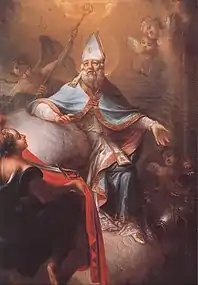Stephan Dorfmeister
Stephan Dorfmeister or, in Hungarian, Dorffmaister István (1729 in Vienna – 29 May 1797, in Ödenburg) was a painter of German origin who worked primarily in Burgenland and Transdanubia (now part of Hungary).

Biography
A birth year of 1729 is assumed, based on parish registers from the city of Ödenburg. Hungarian sources indicate that the year was 1725.[1] He was the eldest of five children born to Johann Christof Georg Dorfmeister (1705–1789) and his wife Elisabeth, née Millner. His youngest brother was the Austrian sculptor, Johann Georg Dorfmeister.
From 1751 to 1758, he studied at the Academy of Fine Arts, Vienna, where his instructors were Paul Troger, the Rector of the Academy, and Caspar Franz Sambach, a fresco painter from Silesia. From 1769, he referred to himself as a "foreign" member of the Academy, although there are no supporting documents.
After acquiring an expertise in fresco painting, c.1760,[2] he received an order from the Provost of the Premonstratensian abbey in Gschirna for painting the monastery church. In 1761, he worked at the new monastery in Türje. Around 1762, he moved to a home near Ödenburg, but never became a Bürger (citizen) there; possibly to avoid compulsory military service.[1] During this time, he married Anna Franz and they had nine children together. After her death in 1790, he married Katharina Gillig.
he worked mainly in what is now Western Hungary. His primary customers were the Bishops of Steinamanger and Fünfkirchen, as well the region's numerous monasteries. He also had some clientele among the nobility. Many of the secular buildings he decorated have since been destroyed or demolished. Surviving examples include the hall in Nádasdy Castle, the decorations at the Hegyfalu castles near Kotenburg an der Raab and the municipal theater in Ödenburg. About fifty portraits are known to be his.
His three eldest sons assisted in his workshop. The eldest of them, Stephan Joseph Dorfmeister the Younger (1764-1807) helped with projects in Sankt Gotthard. Many works created after 1797 were jointly signed. His next eldest, Joseph Paul Stephan Dorfmeister (born 1770), remained with him in his workshop and completed his last commission; the altarpiece at the church in Magotsch (1798).
Despite his thriving business, he was plagued by financial problems his entire life and left his family deeply in debt.[1]
Selected works
 1778: The Transfiguration of Saint Martin
1778: The Transfiguration of Saint Martin 1780: Portrait of the poet, Barkóczy Borbála
1780: Portrait of the poet, Barkóczy Borbála.jpg.webp) 1782: The Pentecost Miracle
1782: The Pentecost Miracle 1794–95: Abbott Marian Reutter with the Lyceum teachers of Steinamanger
1794–95: Abbott Marian Reutter with the Lyceum teachers of Steinamanger 1795–96: Kaiser Karl VI with Abbott Robert Leeb in Sankt Gotthard
1795–96: Kaiser Karl VI with Abbott Robert Leeb in Sankt Gotthard 1795–96: The Death of Ludwig II at the Battle of Mohacs
1795–96: The Death of Ludwig II at the Battle of Mohacs 1796: King Béla III, founding the Cistercian monastery of Sankt Gotthard
1796: King Béla III, founding the Cistercian monastery of Sankt Gotthard
References
- Művészeti Lexikon (Eds. Zádor, Anna – Genthon, István) Budapest 1965, Vol.I. (Article by Endre Csatkai)
- Karoly Garas: "A soproni Edlinger ház és Gregorio Guglielmi [Das Edlinger-Haus in Sopron (Ödenburg) und Gregorio Guglielmi]". In: Tanulmányok Csatkai Endre emlékére [Studien in memóriám Endre Csatkai]. Ed., Környei, A. – G. Szende, K. Sopron 1996
Further reading
- M. Fábián: Dorffmaister István múvészi munkássága a szombathelyi egyházmegyében (German: Stephen Dorffmaister künstlerische Arbeiten im Bistum Steinamanger), Szombathely, 1936.
- Gy. Géfin: A Szombathelyi székesegyház (German: Die Kathedrale von Steinamanger), Szombathely, 1945.
- L. Kostyál und M. Zsámbéky: Katalog "Stephanus Dorffmaister pinxit"; Gedenkausstellung von Stephan Dorffmaister, Szombathely, 1998.
External links
![]() Media related to Stephan Dorfmeister at Wikimedia Commons
Media related to Stephan Dorfmeister at Wikimedia Commons